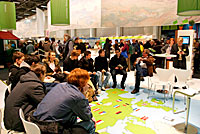TNC Overview
What is Cooperation?
Cooperation: the basics
Cooperation encourages and supports LAGs to undertake joint actions with other LAGs, or with a group taking a similar approach, in another region, Member State, or even a third country. Two main types of cooperation are noted by the European Commission in their ‘Guide for the Implementation of the measure for cooperation under the current RDPs’ Leader axis. These are:
-
Inter-territorial cooperation - This refers to cooperation between different rural areas within a Member State. Cooperation within a Member State concerns at least one LAG selected under the Leader axis and it is open to other local groups using a similar participatory approach; and
-
Transnational cooperation - which is defined as cooperation between different rural areas from at least two Member States. Transnational cooperation covers at least one LAG selected under the Leader axis and additional partners could include other local groups using similar participatory approach. It is also possible to extend this cooperation to groups in third countries following a similar approach.
Subsection 4 of Commission Regulation (EC) 1974/2006 provides further orientation about the official ‘rules of the game’ for these types of cooperation under the EAFRD
Joint Action
Cooperation projects correspond to concrete actions with clearly identified deliverables producing benefits for each of the territories involved. These actions must be ‘joint’ in the sense that they are being jointly implemented. The content of such joint actions may cover a range of different activities eligible under the RDPs’ rules.
Joint approaches allow LAGs from one area to contribute funding to joint project that may be happening in another territory. The location of the project is not a limiting factor if the LAG area benefits from the joint project actions Examples of eligible joint actions (subject to national rules for RDP implementation) include capacity building or knowledge transfer via common publications, training seminars, twinning arrangements (exchange of programme managers and staff) leading to the adoption of common methodological and working methods, or to the elaboration of a joint or coordinated development work.
Cooperation and networking
Cooperation concepts are often closely related to networking concepts, since networking may foster cooperation and cooperation may result in creating new thematic networks. Establishing a new network can also be seen as a joint action, but ‘networking for networking sake’ is generally not considered as useful as networking based around the implementation of a specific rural development action. Cooperation projects should therefore:
- address issues and themes important for the participating rural areas;
- complement aims noted in LAGs’ local development strategies;
- bring some significant added-value to the LAG areas, the activities targeted, the actors involved or, more widely, the local population; and
- be implemented with well defined and realistic objectives.
In order for tangible results to be achievable, the limits of the project will need to be determined well in advance.
Note: Initial cooperation activity can involve establishing ‘prototype’ partnerships to investigate options for, and/or the feasibility of, of concrete joint actions. Such preliminary work can obtain financial support in some Member States. Examples of different types of preparatory cooperation actions are presented in the table below.
| Type of ‘proto-type’ partnership activity | Objective |
|---|---|
| Study visit | Understand how a potential partner solves a specific problem or addresses a specific issue in their local environment |
| Exchange of information, experience and/or good practices | Exchange between areas or actors with similar characteristics or resources to identify potential topics of mutual interest and joint learning opportunities |
Proto-type partnership activity examples: Exchange of information, experience and/or good practices






